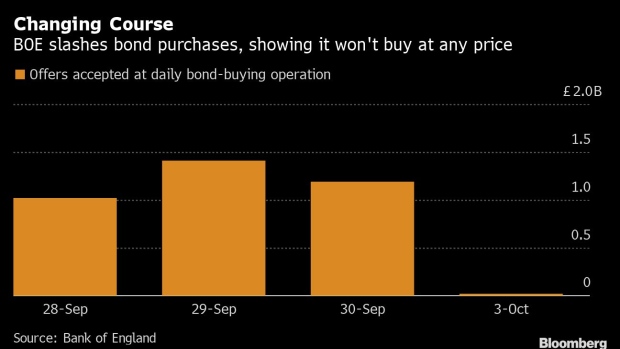Oct 4, 2022
UK Yield Curve Normalizes After BOE Scales Down Gilt Buying
, Bloomberg News

(Bloomberg) -- A key UK yield curve normalized after being inverted since the Bank of England’s extraordinary market intervention last week as the central bank scales down its purchases of long-dated gilts.
The yield premium of 30-year bonds over 10-year equivalents rose as much as 20 basis points on Tuesday to 11 basis points -- returning to positive territory where it had been since 2008.
The BOE announced Tuesday that it didn’t buy any bonds offered in its long-bond buying operation, following a £22 million purchase on Monday and an average of around £1.2 billion last week. The 30-year yield climbed to almost 4% after Tuesday’s announcement, before retracing some of the move.
It’s a rapid reversal for the curve, which had inverted as much as 33 basis points last week. The distortion reflected the BOE exclusively buying bonds with maturities beyond 20 years to backstop a disorderly market selloff fueled by collateral calls.
Read more: UK Pension Strategy That Gilt Market Relied On Becomes Big Risk
Monday’s scaled down bond-buying operation result surprised investors by making it clear the BOE would not always buy a significant amount of securities. Officials followed with a market notice which said it is studying patterns of demand and will continue to set a maximum price it is willing to pay to ensure the “backstop objective of the tool is delivered.”
“The BOE understands that the more it buys now, the harder it becomes to sell these bonds back to the market in the future, and therefore isn’t going to buy an unnecessarily high amount of gilts,” said Imogen Bachra, head of UK rates strategy at NatWest Markets, adding that she sees further steepening of the curve once BOE operations end. “The direction of travel in yields over the medium term should still be higher.”
The BOE has spent about £3.7 billion on the facility so far, well below the maximum of £25 billion over the five days it’s been running.
Longer-maturity bonds extended their relative weakness Tuesday after a sale of 2061 bonds had an unusually large tail, or the difference between the average and lowest price paid. That reflects the UK accepting weaker bids to sell the debt.
(Updates with details of Tuesday’s tender.)
©2022 Bloomberg L.P.





